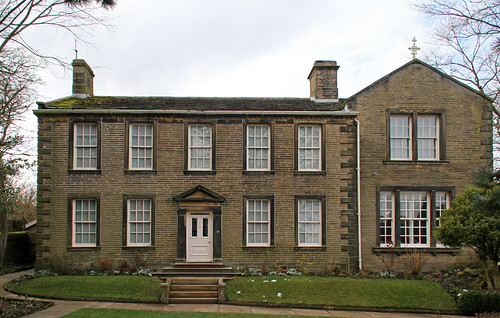Brontë Parsonage Museum (Haworth House)
Brontë Parsonage Museum in Haworth; Courtesy of Flickr/Tony Hisgett
Established in 1779, Haworth Parsonage is located in West Yorkshire and became home to the Brontë family in 1820 (The Editors of Encyclopedia Britannica). When Patrick Brontë died in 1861, contents of the Parsonage had been sold or had gone to Charlotte’s husband and other Brontë family friends or servants, leaving the residence empty of Brontë-related items until 1928 when Sir James Roberts, a wool merchant from Haworth, purchased and donated the Parsonage to the Brontë Society originally founded in 1893 (“Our History”). Haworth Parsonage has since become known as the Brontë Parsonage Museum, the “world’s largest collection of Brontëana” which consists of an “extensive collection of Brontë manuscripts, letters, first editions and personal effects” largely contributed by Brontë Society purchases and donations from society members such as Philadelphia publisher Henry Houston Bonnell (“Our History”). According to the Brontë Society website, the museum offers guided tours and views of the Brontë residence and surrounding Haworth village, much like described in Jasper Fforde’s The Eyre Affair.
In Fforde’s novel, Thursday Next references the old Brontë residence in her recollection of her 1958 visit there with her aunt and uncle. She claims this is where she and Mr. Rochester had “first encountered each other” and goes on to describe the museum’s tour with a “prize exhibit in the form of the original manuscript of Jane Eyre” at the end as well as a shop with “picture postcards, commemorative plates, small plastic imitation Heathcliffs and other mementos” (Fforde 63-64). Hanging back in the room with the original manuscript, a tourist reads a portion of Jane Eyre to Thursday, prompting the young girl to envision before her the meeting of Jane and Mr. Rochester with Rochester having the ability to see her as well. After describing her imagined encounter with Mr. Rochester, Thursday explains she “returned to the museum a few times after that but the magic never worked again” with her mind having “closed too much” (Fforde 69).
Dining room of Brontë Parsonage Museum; Courtesy of Flickr/Chris Neale
The integration of a visit to Haworth House not only indicates that Fforde may not necessarily be working within the narrative framework of Charlotte Brontë’s Jane Eyre, at least not as strictly as adaptations like Margot Livesey’s The Flight of Gemma Hardy, but it also shows Fforde’s familiarity and recognition of the Brontëan legacy. Although Thursday does not seem to be standing in the dining room, this imaginative scene seems reminiscent of the Brontë sisters’ creativity and the history of them doing “most of their writing” for novels like Jane Eyre, Wuthering Heights, and Agnes Grey in that very building in the nineteenth century (“The Dining Room”). It also seems to be a subtle nod to Fforde’s later inclusion of supernatural elements and plot points related to an alternate history as he successfully blends the realistic depiction of the Brontë Parsonage Museum with the more supernatural, imaginative “encounter” with Rochester that Thursday largely attributes to “an overactive imagination” up until he seems to reappear outside Styx’s apartment (70).
Works Cited
Britannica, The Editors of Encyclopaedia. "Haworth." Encyclopedia Britannica, 28 Feb. 2019, https://www.britannica.com/place/Haworth. Accessed 8 April 2022.
“The Dining Room.” The Brontë Society, https://www.bronte.org.uk/museum-and-library/inside-the-parsonage/dining-room. Accessed 8 Apr. 2022.
Fforde, Jasper. The Eyre Affair. Penguin, 2001.
Hisgett, Tony. “Bronte Parsonage Haworth.” Flickr, 9 Mar. 2018, https://flic.kr/p/23FWzpt/. Accessed 10 Apr. 2022.
Neale, Chris. “Bronte Parsonage Museum.” Flickr, 11 Sept. 2011, https://flic.kr/p/antnf1. Accessed 10 Apr. 2022.
“Our History.” The Brontë Society, https://www.bronte.org.uk/about-us/our-history. Accessed 8 Apr. 2022.
Coordinates
Longitude: -1.957630000000


